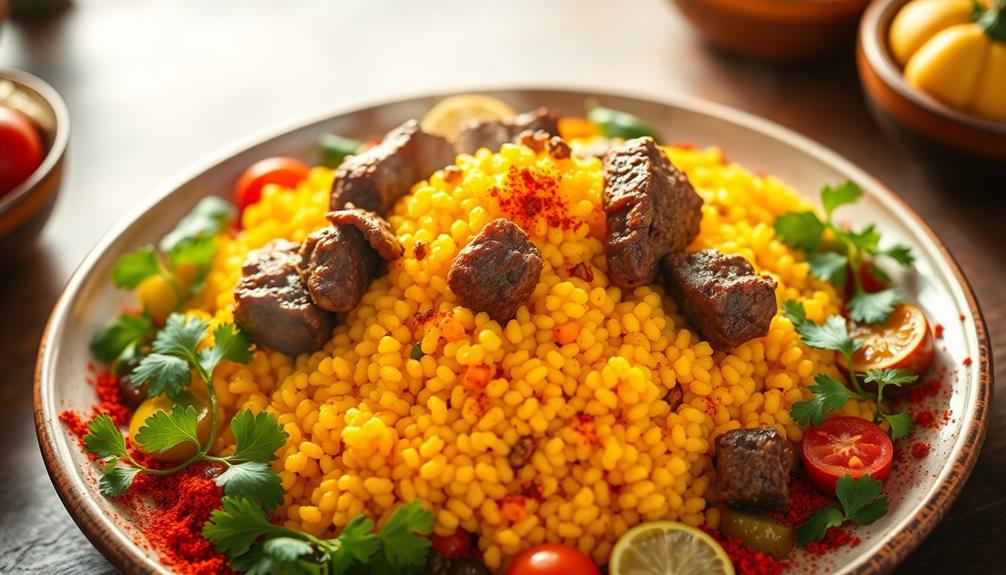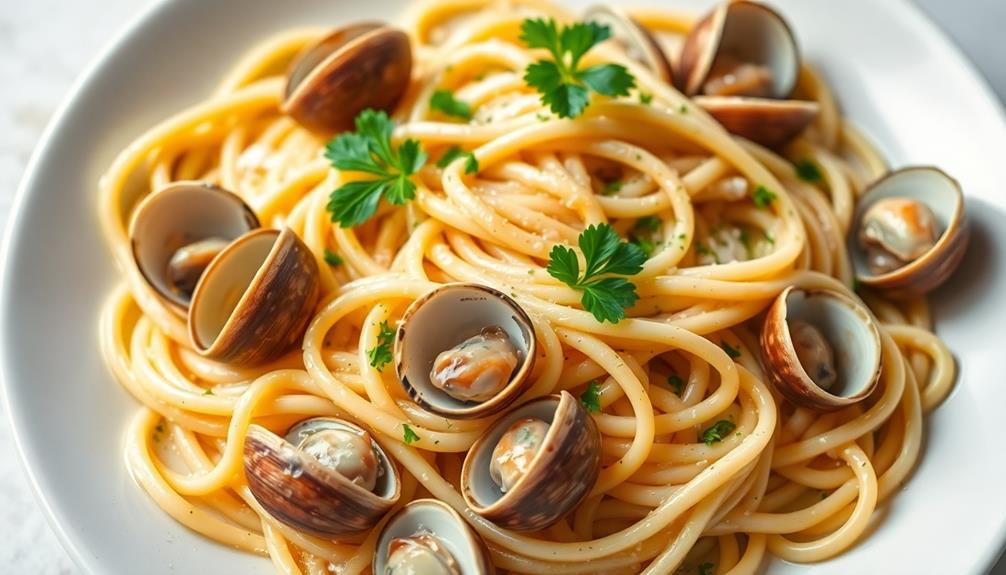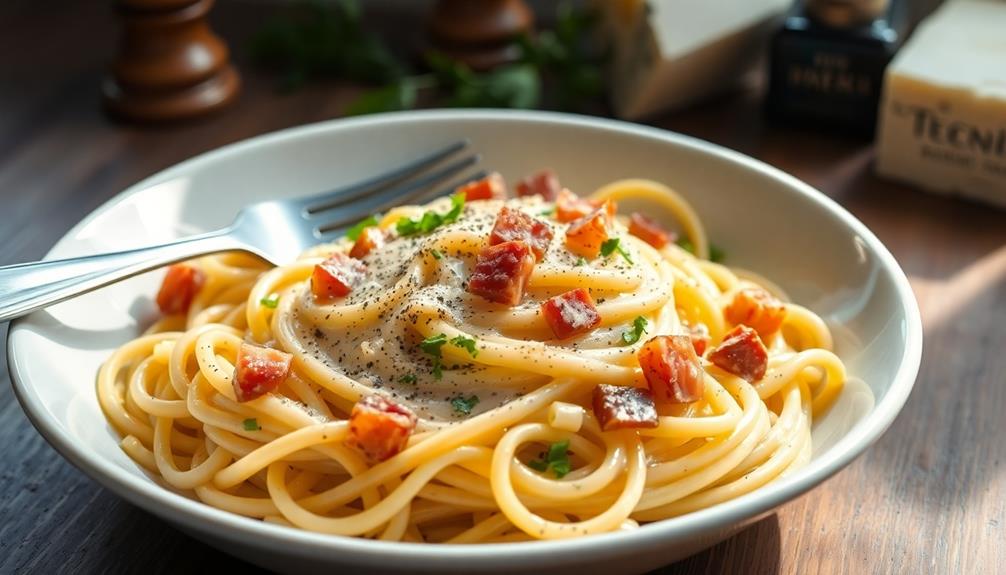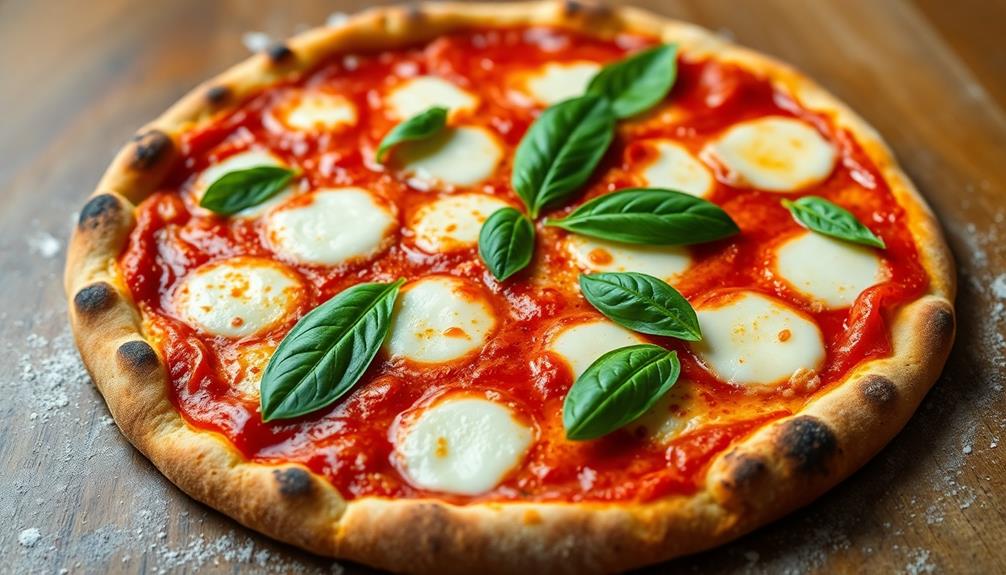You're in for a real treat – carpaccio is a delightful Italian appetizer that'll wow your taste buds! Originating in Venice in the 1950s, it features paper-thin slices of fresh, high-quality beef or fish, dressed up with bright lemon juice, rich olive oil, and shavings of savory Parmesan. The key is using the freshest ingredients and slicing them just right to achieve that signature melt-in-your-mouth texture. Finish it off with a sprinkle of salt and pepper, and maybe even a drizzle of balsamic glaze for an extra pop of flavor. Yum! If you're curious to learn more about this culinary delight, keep reading.
Key Takeaways
- Carpaccio is an Italian appetizer dish featuring thinly sliced raw beef or fish, typically dressed with olive oil, lemon, and Parmesan cheese.
- It was invented in the 1950s at Harry's Bar in Venice, Italy, and named after Venetian painter Vittore Carpaccio.
- The key to a successful carpaccio lies in the quality and freshness of the ingredients, with a sharp knife essential for achieving the desired paper-thin consistency.
- Carpaccio is low in carbohydrates, high in protein, and contains healthy fats when dressed with olive oil, making it suitable for low-carb diets.
- Carpaccio is celebrated for its aesthetic appeal and presentation, highlighting the importance of fresh, quality ingredients in Italian cuisine.
History
Although the origins of carpaccio aren't definitively known, it's believed to have been invented in the 1950s at Harry's Bar in Venice, Italy. This classic Italian dish, named after the famous Venetian painter Vittore Carpaccio, features thinly sliced raw beef or fish, dressed with a light dressing and often garnished with shaved Parmesan cheese or arugula.
The creation of carpaccio is thought to have been inspired by the artist's vibrant use of color in his paintings. The delicate, paper-thin slices of meat or fish resemble the brushstrokes on a canvas, making it a visually stunning and appetizing dish.
Over the years, carpaccio has become a beloved staple on menus across Italy and around the world, delighting diners with its simple yet sophisticated flavors. One of the most popular variations is beef carpaccio, thinly sliced raw beef drizzled with olive oil, lemon juice, and topped with shaved Parmesan cheese. This dish is often served as an appetizer and is known for its delicate, melt-in-your-mouth texture. Another beloved Italian dish is the traditional cacio e pepe recipe, a simple but delicious pasta dish made with just black pepper, Pecorino Romano cheese, and spaghetti. Both of these dishes showcase the beauty of Italian cuisine in their simplicity and bold flavors.
Recipe
Carpaccio is a classic Italian dish featuring thinly sliced raw beef or fish, typically served as an appetizer. This refreshing and elegant dish showcases the natural flavors of the main ingredient.
The key to a successful carpaccio lies in the quality and freshness of the meat or fish, as well as the precision of the slicing. A sharp knife and a steady hand are essential to achieve the desired paper-thin consistency.
Ingredients:
- 8 oz beef tenderloin or sashimi-grade tuna or salmon
- 2 tbsp olive oil
- 1 tbsp lemon juice
- Salt and freshly ground black pepper to taste
- Arugula or mixed greens
- Parmesan cheese, shaved or grated (optional)
Instructions: Slice the meat or fish into paper-thin slices, using a sharp knife or a meat slicer if available. Arrange the slices in a single layer on a large plate or platter. Drizzle the olive oil and lemon juice over the slices, and season with salt and pepper to taste.
Top with a handful of arugula or mixed greens, and garnish with shaved or grated Parmesan cheese, if desired.
When preparing carpaccio, it's important to use the freshest and highest-quality ingredients possible. For beef, choose a tender cut like tenderloin or filet mignon. For seafood, opt for sashimi-grade fish to ensure optimal freshness and texture.
Experiment with different garnishes and seasonings to suit your personal preferences, such as capers, shallots, or a drizzle of truffle oil.
Cooking Steps
Thinly slice the beef, then dress it with a drizzle of olive oil and a spritz of lemon.
Sprinkle shaved Parmesan over the top, and season generously with salt and pepper.
For an extra touch of flair, you can optionally drizzle a bit of balsamic glaze over the whole dish.
Step 1. Thinly Slice the Beef

To prepare the carpaccio, you'll want to thinly slice the beef. This step is all about getting those slices just right! First, take your chilled beef and use a very sharp knife to carefully slice it into paper-thin pieces.
Don't worry if they aren't perfect – the irregularity adds to the rustic charm.
Next, arrange the slices in an overlapping, fan-like pattern on your serving platter. This creates a beautiful presentation that's sure to impress your guests. If any of the slices are a bit thick, simply use the flat side of your knife to gently pound them down until they're nice and thin.
Once your beef is perfectly sliced, you can move on to seasoning and dressing the carpaccio. Get ready for some seriously delicious flavors!
Just remember to take your time and enjoy the process. Homemade carpaccio is a real labor of love, but the end result is absolutely worth it.
Step 2. Dress With Olive Oil, Lemon

Once the beef is beautifully sliced, you'll want to dress the carpaccio with a light and flavorful vinaigrette.
Start by drizzling a high-quality extra virgin olive oil over the delicate slices. The rich, fruity olive oil will add a lovely shine and complement the tender beef.
Next, give the carpaccio a fresh, tangy twist by squeezing some fresh lemon juice over the top. The bright acidity of the lemon will cut through the richness of the meat and awaken your taste buds.
Be sure to use just enough lemon to brighten the dish without overpowering it.
Step 3. Garnish With Shaved Parmesan
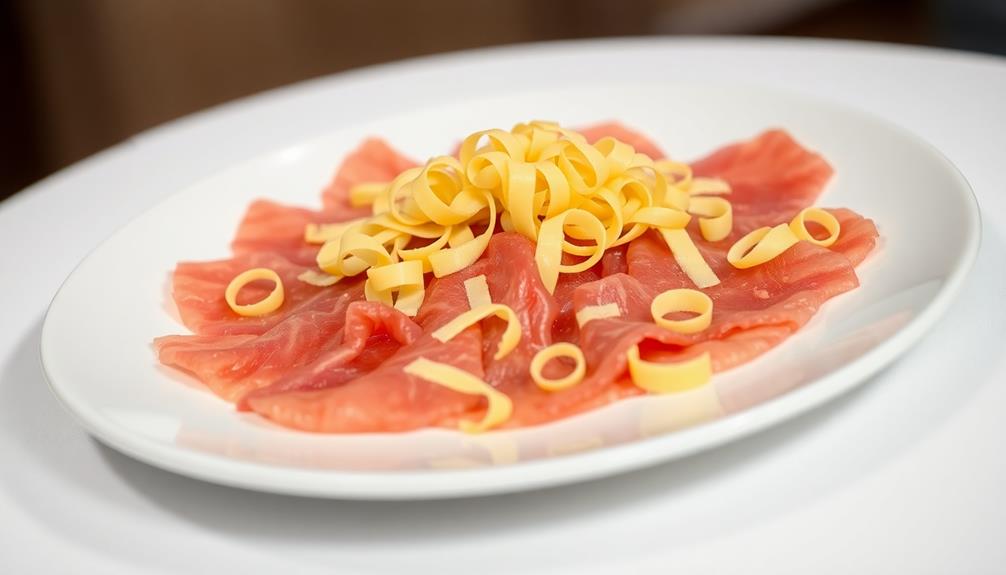
A sprinkle of Parmesan cheese is the perfect finishing touch for your carpaccio.
Imagine the delightful contrast as the savory, umami-rich Parmesan flakes melt on your tongue, complementing the tender, paper-thin slices of beef.
To create this gourmet garnish, use a sharp vegetable peeler to shave thin ribbons of Parmesan directly over the top of your carpaccio.
Let the cheese cascade down, creating a beautifully textured topping.
Don't be shy – a generous amount of Parmesan will elevate your dish to new heights!
The salty, slightly nutty cheese adds a burst of flavor that perfectly balances the delicate carpaccio.
Finish with a drizzle of high-quality olive oil and a sprinkle of freshly cracked black pepper.
Get ready to impress your guests with this simple yet sophisticated presentation.
Bon appétit!
Step 4. Season With Salt and Pepper

After you've arranged the carpaccio on your serving platter, it's time to season it with salt and pepper. Go ahead and grab your trusty salt and pepper shakers – you'll want to give the carpaccio a nice, even coating all over.
Be generous with the seasoning, but don't go overboard. Start with a few shakes of salt, focusing on the edges where the meat is thickest. Then, give it a few cracks of black pepper. The salt will help bring out the natural flavors of the beef, while the pepper adds a little zing and complexity.
Once you've seasoned the carpaccio, take a step back and admire your handiwork. The contrast of the pale, delicate beef with the flecks of salt and pepper is simply gorgeous.
Now, all that's left to do is dig in and enjoy this delightful, restaurant-worthy dish. The flavors are going to dance on your taste buds, so get ready for an absolute flavor explosion!
Step 5. Optionally Drizzle With Balsamic Glaze

Enhancing the carpaccio's flavor profile, you can optionally drizzle a balsamic glaze over the top. This tangy, sweet reduction adds a touch of elegance and depth to the dish.
Simply pour a small amount of balsamic vinegar into a saucepan and simmer it gently until it thickens to a syrupy consistency. The key is to let the glaze reduce slowly, allowing the flavors to concentrate and become more complex.
Once your balsamic glaze is ready, use a spoon to carefully drizzle it over the carpaccio in a zigzag pattern. The glossy, dark liquid will beautifully complement the delicate slices of meat.
The contrasting textures and flavors create a truly appetizing presentation that's sure to impress your family and friends. Feel free to experiment with the amount of glaze, adjusting it to your personal taste preferences.
Enjoy the harmonious blend of savory and sweet in every bite!
Final Thoughts
Carpaccio, a delectable Italian dish, has captured the hearts and palates of food enthusiasts worldwide. As you savor the paper-thin slices of raw beef or fish, you can't help but marvel at the simplicity and elegance of this classic preparation.
The final touches are what truly make it shine – a drizzle of fragrant olive oil, a sprinkle of Parmesan, and a vibrant garnish of fresh greens or herbs. Its presentation often evokes the same appreciation found in dishes like Cacciucco and ribollita, where fresh ingredients are highlighted beautifully.
The beauty of carpaccio lies in its ability to showcase the natural flavors of the main ingredient. Whether you opt for a traditional beef version or venture into seafood territory, each bite offers a burst of freshness and a symphony of textures.
It's a dish that excites the senses and leaves you craving more. As you indulge in this culinary delight, remember to savor every moment. Carpaccio isn't just a meal, but a celebration of the simple, yet exquisite, pleasures in life.
Frequently Asked Questions
Is Carpaccio Served Warm or Cold?
You'll typically find carpaccio served cold, as the dish is meant to showcase the natural flavors and tenderness of the raw, thinly sliced meat or fish. Its chilled presentation enhances the delicate texture and prevents the ingredients from overcooking.
What Type of Meat Is Typically Used for Carpaccio?
Typically, you'll find that beef is the go-to meat for carpaccio. The thinly sliced raw beef is often seasoned with olive oil, lemon juice, and sometimes Parmesan cheese, creating a simple yet flavorful dish.
How Thinly Should the Meat Be Sliced for Carpaccio?
For the best carpaccio, you'll want to slice the meat as thinly as possible, almost translucent. Aim for pieces that are just a few millimeters thick to create the delicate, melt-in-your-mouth texture that defines this classic dish.
Can Vegetarians Enjoy Carpaccio, and if So, How?
Yes, vegetarians can enjoy carpaccio-style dishes. Try thinly slicing raw vegetables like beets, zucchini, or carrots, then drizzle with a tangy dressing for a fresh, flavorful take on this classic preparation.
How Long Can Leftover Carpaccio Be Stored?
You can store leftover carpaccio in the refrigerator for 3-4 days. Make sure to keep it in an airtight container and consume it within that time frame for the best quality and food safety.

